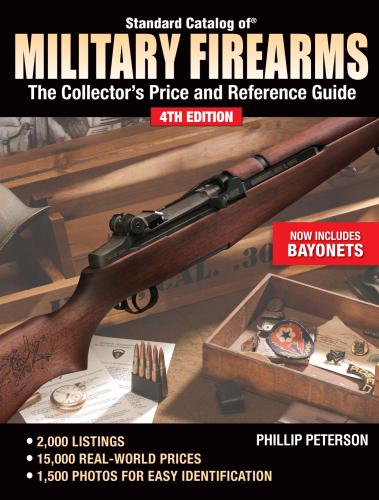Australian L1A1 Rifle • Courtesy Blake Stevens, The FAL Rifle
MACHINE GUNS
Between 1925 and 1930 the Australian firm of Lithgow built the Vickers machine gun. Later, between 1938 and 1940, the same company built the Bren gun in .303 caliber. Approximately 12,000 Vickers and 17,000 Bren guns were built in Australia during this period. After World War II the Australian military adopted the U.S. M60 machine gun, the Browning 1919A4, and the .50 caliber Browning M2HB. More recently, that country’s military uses the Belgian FN MAG, and the German MG3.
Australian Bren
This is a slightly modified version of the MK I built by the Small Arms Factory, Lithgow, beginning in 1940. Marked “MA” and “LITHGOW” on the right side of the receiver. A total of 17,429 guns were produced when production stopped August 13, 1945.
Pre-1968 (Extremely Rare)
| Exc. | V.G. | Fair |
| 40000 | 37500 | 30000 |
Australian Vickers
Manufactured by the Small Arms Factory in Lithgow beginning in 1929. The gun was last built in 1945. Serial numbers began with the number 1 and went to 9,999. From then on the prefix “B” was added. Highest serial number recorded is B2344.
Pre-1968
| Exc. | V.G. | Fair |
| N/A | — | — |
Pre-1986 conversions (side-plate using Colt 1915 or 1918 plates)
| Exc. | V.G. | Fair |
| 17500 | 15000 | 12500 |
AUSTRIA/HUNGARY & AUSTRIA
Austrian/Hungarian Military Conflicts, 1870-Present
In 1867 the Austro-Hungarian monarchy ruled this important and critical part of Europe. Germany and Austria-Hungary entered into an alliance called the Dual Alliance and later, in 1882 when Italy joined, the Triple Alliance. In the same year Serbia and Romania joined this group as well. Eventually this partnership between Germany and Austria-Hungary pitted them against England and France for control of Europe. With the advent of World War I and the defeat of the Dual Alliance, the Austrian-Hungarian rule came to an end. Between 1914 and 1918 Austria-Hungary had a total of 7,800,000 serving in its armed forces. By the end of the war 2,482,870 had been killed or wounded, about 1/3 of total military personnel. In 1918 German Austria became a republic. The small nation was beset by social, economic, and political unrest throughout the 1920s and in 1934 a totalitarian regime was established. Austria became part of the German Third Reich in 1938. After the end of World War II, Austria was restored to a republic and occupied by the allies until 1955 when it became a sovereign nation. Austria joined the European Union in 1995.
HANDGUNS
Model 1870
This revolver is built on a Lefaucheux-Francotte double action solid frame with fixed cylinder with mechanical rod ejection. It is chambered for the 11.3mm cartridge and fitted with a 7.3" round barrel. The non-fluted cylinder holds 6 rounds. The frame and barrel were iron, not steel. Checkered wooden grips with lanyard loop. Built by the Austrian firm of Leopold Gasser, and marked “L.GASSER, WIEN, PATENT, OTTAKRING.” Weight is about 53 oz., or 3.3 lbs., making it one of the heaviest military service revolvers of its time. When the Model 1878 was introduced and adopted by the Austro-Hungarian army, the Model 1870 was sold to the Balkan States and was sometimes referred to as the “Montenegrin” revolver.
Model 1870 • Courtesy J. B. Wood
Model 1870/74 Gasser Trooper’s Model
Similar to the above model but built with cast steel instead of iron. It was issued from 1874 to 1919. Built by the Austrian firm of Leopold Gasser. Weight is still about 53 oz.
Model 1878 Officer’s Model
Because the Model 1870 revolver was so heavy and large, Johann Gasser, Leopold’s younger brother, designed a smaller version chambered for the 9mm (9x26) cartridge. The barrel length was 4.8" and the overall length was reduced as well. The weight of this revolver was about 27 oz.
Model 1898 Rast & Gasser
This model was built on the Schmidt-Galand double action solid frame with 8-round cylinder with loading gate and mechanical ejection rod. Chambered for the 8mm cartridge and fitted with a 4.5" round barrel. The caliber was too light to be effective as a military sidearm. The firing pin was a spring-loaded frame-mounted plunger instead of the more common hammer mounted type. Checkered wooden grips with lanyard loop. In service from 1898 to 1938. Weight is about 33 oz.
Courtesy Geschichte und Technik der europaischen Militarrevolver,
Journal-Verlag Schwend GmbH with permission
Model 1898 • Paul Goodwin photo
STEYR
Osterreichische Waffenfabrik Gesellschaft GmbH,
Steyr (1869-1919)
Steyr-Werke AG (1919-1934)
Steyr-Daimler-Puch, Steyr (1934-1990)
Steyr-Mannlicher GmbH, Steyr (1990-)
Steyr Model 1893 Gas Seal Test Revolver
Chambered for the 8mm cartridge this 7-shot 5.5" barrel revolver was built by Steyr as a prototype for the Austrian army. Fewer than 100 were built. Several different variations. It is recommended that an expert be consulted prior to a sale.
Courtesy Geschichte und Technik der europaischen Militarrevolver,
Journal-Verlag Schwend GmbH
